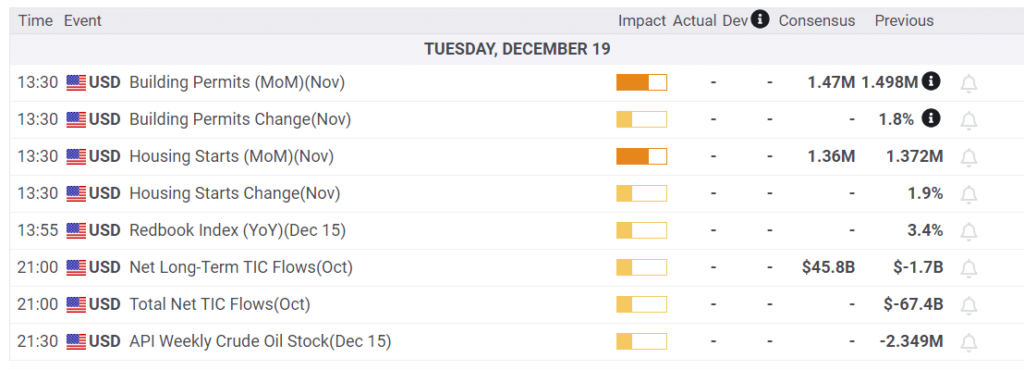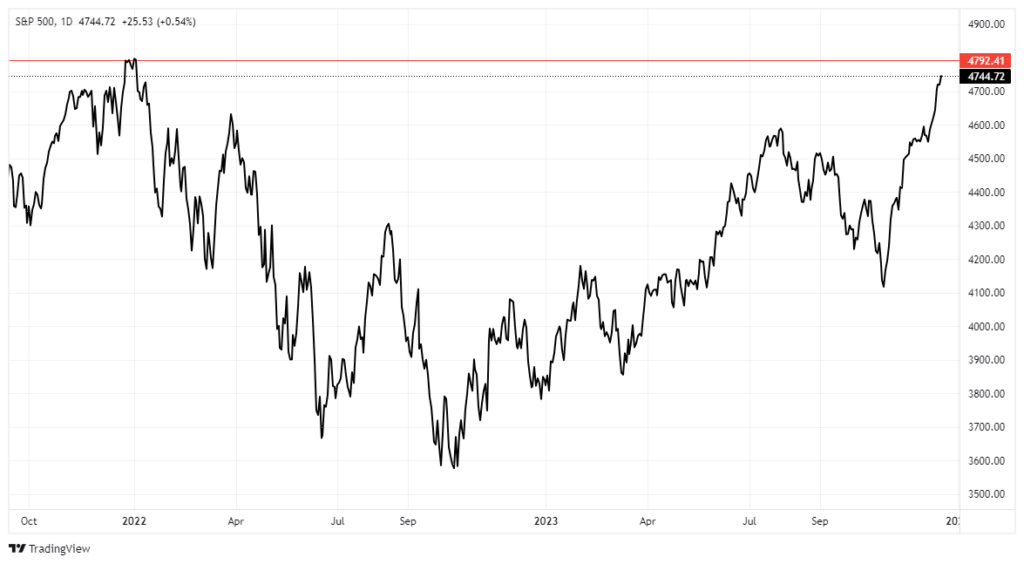The S&P 500 is only 2% below record highs set two years ago. It appears highly likely the index will set new record highs in the next week or so. The bigger question is what comes after that. While the Fed’s policy stance, economic data, and coming Q4 earnings will help form expectations, let’s focus today on the market’s breadth for clues. The breadth of a market is an excellent way to assess if a price trend is healthy. Sustainable bullish trends are often accompanied by solid breadth, meaning many stocks, not just a few leaders, support the trend. For most of 2023, a small handful of stocks produced a large majority of the gains. Recently, however, a much larger group of stocks is contributing.
The graph on the top left shows 22% of the Nasdaq 100 are at 52-week highs. That is the highest percentage since the 2021 record highs. The graph below charts the bullish percentage index, or the number of stocks on point and figure buy signals. As circled, a high number of stocks are sending buy signals. The table on the top right, courtesy of SimpleVisor, shows that every sector has a positive technical score. Further, eight of them are above 50. Throughout most of this year, it was common to see a handful of sectors with negative scores despite upward momentum. Lastly, per Goldman Sachs, 46% of S&P 500 components have an RSI above 70, the highest since 1991. The data show the market is overbought. While a short-term decline is likely, the graphics point to positive breadth, which could propel the market higher to start 2024.

What To Watch Today
Earnings

Economy

Market Trading Update
There seems to be nothing to stop the market from setting all-time highs at this point.

There are two important points to make.
The first is that while the market is overbought and very extended, it is so close to all-time highs that it has become a magnet for traders. As such, a concerted effort will likely be to hit that level by year-end.
The second point is more important. The difference between a “bear market” and a “correction.”
To answer that question, let’s clarify the premise.
- A bull market is when the price of the market is trending higher over a long-term period.
- A bear market is when the previous advance breaks and prices begin to trend lower.
The chart below provides a visual of the distinction. When you look at price “trends,” the difference becomes both apparent and useful.

The distinction is essential.
- “Corrections” generally occur over short time frames, do not break the prevailing price trend, and are quickly resolved by markets reversing to new highs.
- “Bear Markets” tend to be long-term affairs where prices grind sideways or lower over several months as valuations are reverted.
Using monthly closing data, the “correction” in 2022 did not break the long-term bullish trend. Such suggests the bull market that began in 2009 is still intact as long as the monthly trend line holds.
Does this mean a real “bear market” won’t ever happen? No.
However, it does suggest that, for now, the market price trend is higher, and the longer-term bull market remains intact.

Fed Members Pushback
Last week, Jerome Powell and the Fed surprised the markets by implying that rate cuts are on the horizon. To wit, Powell stated the following:
And that’s really the question that we’re on, but of course, the other question, the question of when will it become appropriate to begin dialing back the amount of policy restraint in place, that begins to come into view, and is clearly a topic of discussion out in the world and also a discussion for us at our meeting today
Last Friday and continuing Monday, Fed members are pushing back against the notion of rate cuts coming soon. John Williams, President of the NY Fed, was pretty blunt, stating: “We aren’t really talking about rate cuts right now.” Fed Presidents Mester and Goolsbee also came out trying to push expectations for rate cuts back toward the second half of 2024. In a CNBC interview, Goolsbee said he was confused by the market’s reaction last Wednesday.
As we share below, the markets now put reasonable odds on a rate cut in March and a total of five 25bps rate cuts by year-end. We suspect the Fed will continue to walk back the market’s expectations.

Dis- Versus De-Flation
NPR wrote a thoughtful article helping us appreciate that while CPI and PCE are cooling rapidly, consumers are still grappling with inflation. In a recent Gallup poll, 35% of those surveyed said the high cost of living /inflation was today’s most important financial problem. The next closest answer was the cost of owning/renting a home at 11%, which is also an inflation issue.
The reason the consumers are worried is that they want prices to return to pre-pandemic levels. Per the article:
“Most Americans are not just looking for disinflation,” Fed governor Lisa Cook said last month, during a speech at Duke University. “They’re looking for deflation. They want these prices to be back where they were before the pandemic.”
While people may want deflation, entailing falling prices, the Fed will likely fight hard against it. Instead, as they say regularly, they want disinflation or a low but positive growth rate of prices. The article explains why deflation is not a good thing.
If deflation becomes entrenched, it can be a drag on the broader economy. While it’s always fun to get a discount, when prices are steadily falling across the board, it tends to discourage consumption — which is the biggest engine of U.S. economic growth. Why buy a washing machine today if it’s going to be cheaper next year?
We suspect, given that disinflation, not deflation, will be the likely outcome of the Fed’s policy, that consumer sentiment will remain weak. At some point, however, higher wages will help offset inflation. Consequently, we will get used to the new higher level of prices.

Tweet of the Day

“Want to have better long-term success in managing your portfolio? Here are our 15-trading rules for managing market risks.”
Please subscribe to the daily commentary to receive these updates every morning before the opening bell.
If you found this blog useful, please send it to someone else, share it on social media, or contact us to set up a meeting.


